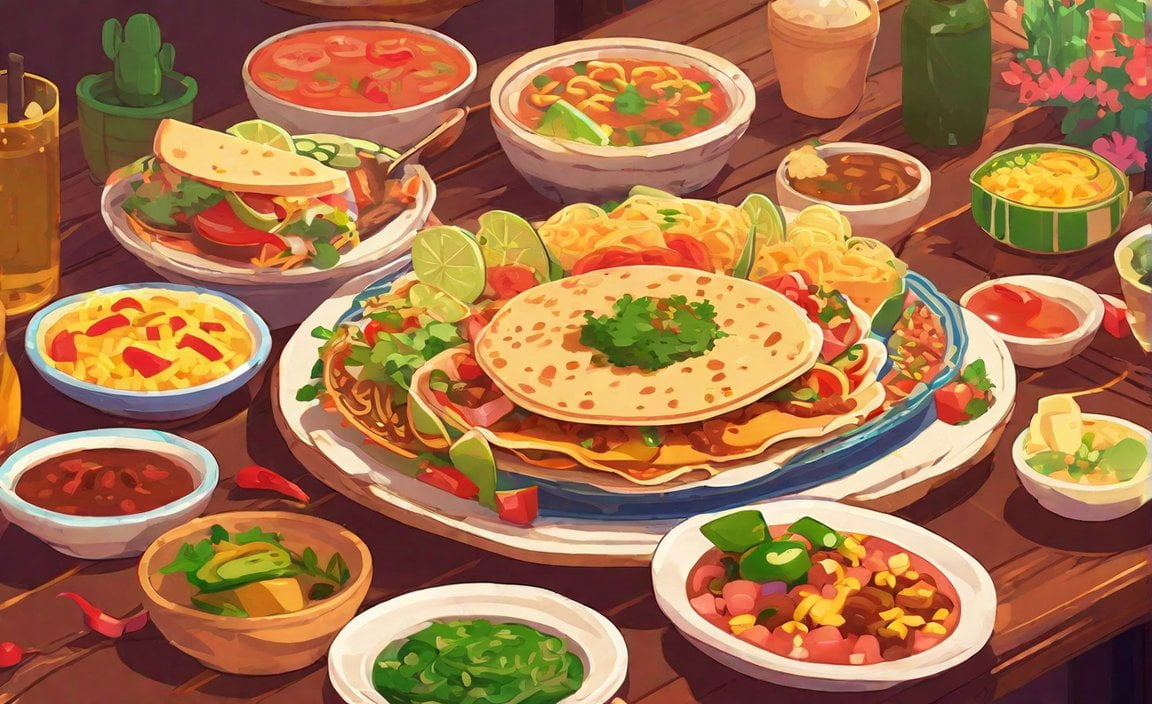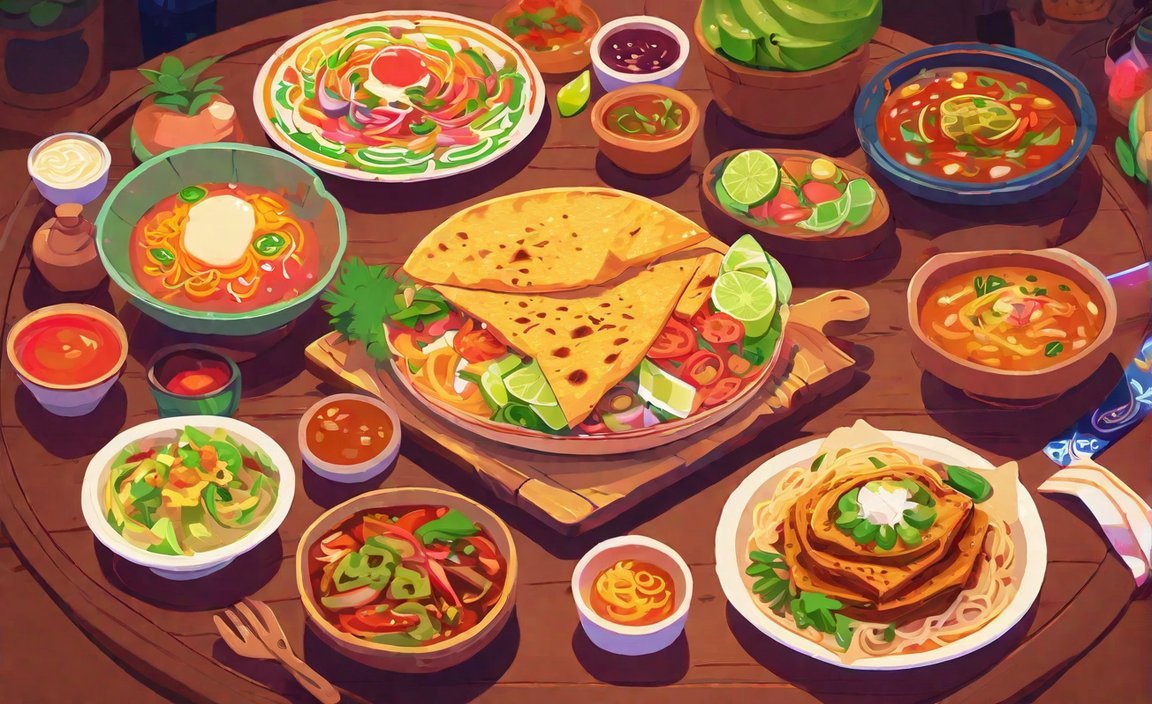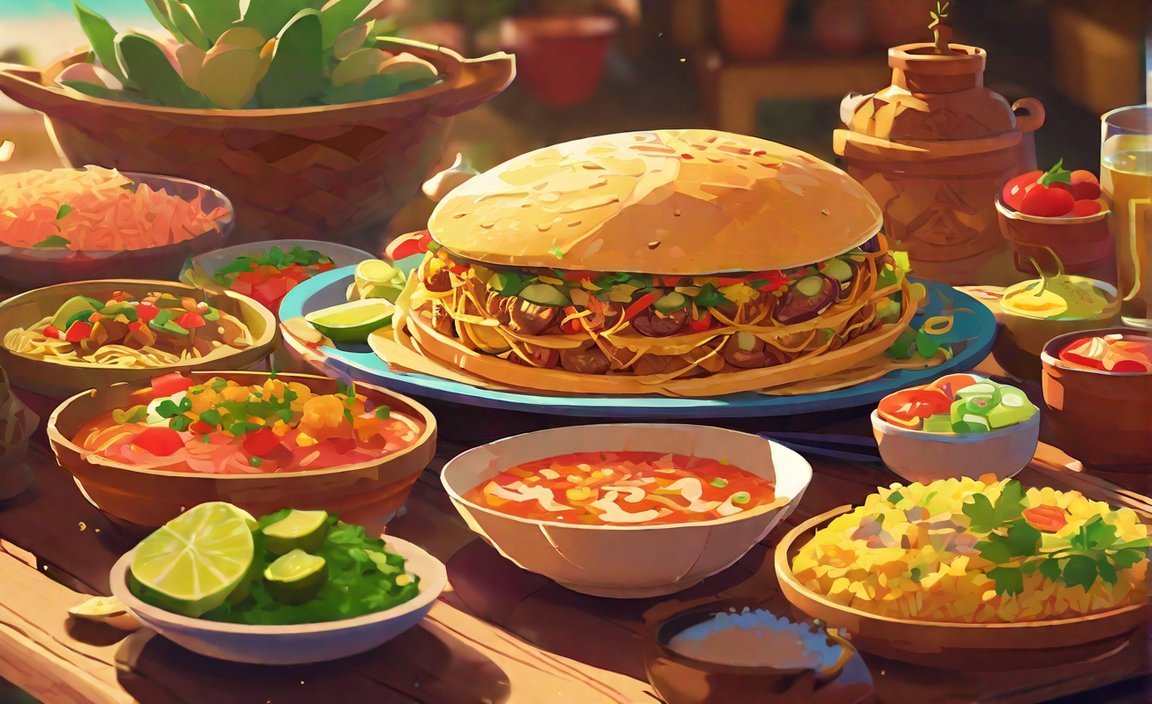Delicious Facts: Exploring Mexican Cuisine is a captivating journey into the enchanting world of Mexican food. Unlocking the secrets and hidden treasures of this vibrant culinary tradition, this article reveals a trove of fascinating facts about Mexican cuisine. From the tantalizing flavors that define its dishes to the cultural and historical significance behind them, prepare to be captivated by the rich tapestry of Mexican gastronomy. Whether you’re a seasoned food aficionado or an eager beginner, this exploration of Mexican cuisine promises to whet your appetite for both knowledge and flavor.

Key Takeaways:
- Mexican cuisine is known for its rich flavors, variety of ingredients, and cultural significance.
- Mexican food incorporates lots of veggies and fruits, making it healthy and nutritious.
- Different regions of Mexico have their own unique styles and influences on Mexican cuisine.
- Mexican food is recognized as a world heritage cuisine by UNESCO for its cultural value.
- Interesting ingredients in Mexican food include chocolate, chilies, corn, cactus, and insects.
- Popular Mexican dishes like Caesar salad, nachos, and fajitas have interesting origins or were invented relatively recently.
- Mexican food often includes lots of veggies and fruits, providing essential nutrients and fiber.
- Spices like chilies used in Mexican food can boost metabolism and have potential health benefits.
- Traditional Mexican cooking methods, such as grilling and steaming, help retain the nutritional value of ingredients.
- Mexican food differs across various regions of the country, reflecting local ingredients and cultural influences.
- Each region of Mexico has its own specialties and unique flavor profiles.
- Mexican cuisine is recognized as a world heritage cuisine by UNESCO, highlighting its cultural importance.
- Traditional Mexican food plays a significant role in festivals and celebrations, showcasing the country’s rich cultural heritage.
- Mexican food has influenced international cuisine, with dishes like tacos and guacamole becoming popular worldwide.
- Mexican cuisine utilizes interesting ingredients like chocolate, chilies, corn, cactus, and insects.
- Chocolate originated in Mexico and was used by the ancient Mayans and Aztecs.
- Chilies are a staple ingredient in many Mexican dishes, adding heat and flavor.
- Corn is a fundamental ingredient in Mexican cuisine, used in various forms like tortillas and tamales.
- Cactus, particularly the nopal, is commonly used in Mexican dishes for its nutritional benefits and unique texture.
- Insects, such as grasshoppers and worms, are consumed in certain regions of Mexico as a good source of protein.
- Popular Mexican dishes like Caesar salad, nachos, and fajitas have interesting origins or inventors.
- Exploring Mexican cuisine allows for a deeper appreciation of its cultural heritage and culinary traditions.
Facts About Mexican Food
Mexican cuisine is a cultural treasure that offers rich flavors, unique ingredients, and a diverse range of dishes. From its nutritional benefits to its fascinating origins, exploring the world of Mexican food is like embarking on a delicious adventure. Let’s delve into some interesting facts about Mexican food that will surely captivate your taste buds and ignite your culinary curiosity.
Health Benefits of Mexican Food
Mexican food is known for its healthy and nutritious qualities. With its emphasis on using fresh vegetables and fruits, Mexican dishes provide essential nutrients and fiber that promote overall well-being. Plus, the incorporation of spices like chilies can boost metabolism and potentially bring health benefits. Traditional Mexican cooking methods, such as grilling and steaming, help retain the nutritional value of the ingredients, making every bite both delightful and nourishing.
Regional Variations in Mexican Food
The beauty of Mexican cuisine lies in its regional variations. From the northern states to the southern regions, each area of Mexico has its own unique specialties and flavor profiles. For example, Oaxaca is famous for its rich and complex mole sauces, while the Yucatan Peninsula offers the exquisite delights of cochinita pibil, a slow-roasted pork dish. Meanwhile, Puebla enchants with its chiles en nogada, a stuffed pepper covered in a creamy walnut sauce. Exploring the regional variations of Mexican food is like discovering a tapestry of flavors and culinary traditions.
Cultural Significance of Mexican Food
Mexican cuisine is more than just food; it is a cultural treasure recognized by UNESCO as a world heritage cuisine. Traditional Mexican dishes play a significant role in festivals and celebrations, showcasing the country’s rich cultural heritage to the world. It’s fascinating to see how Mexican food has also influenced international cuisine, with dishes like tacos and guacamole gaining immense popularity worldwide. By savoring Mexican food, you not only indulge in a delightful culinary experience but also pay homage to a vibrant culture steeped in tradition.
Unique Ingredients in Mexican Food
One of the most intriguing aspects of Mexican cuisine is its use of unique ingredients. The ancient Mayans and Aztecs introduced the world to chocolate, which has its origins in Mexico and remains a beloved ingredient in Mexican desserts and beverages. Chilies, another staple ingredient, add both heat and flavor to countless Mexican dishes. Corn holds a special place in Mexican cuisine, used in various forms like tortillas, tamales, and pozole. Mexican cuisine also embraces cactus, particularly the nopal, known for its nutritional benefits and unique texture. And for the adventurous food enthusiasts, certain regions of Mexico incorporate insects like grasshoppers and worms, providing a good source of protein and a hint of culinary daring.
Popular Mexican Dishes with Interesting Origins
Behind every mouthwatering dish, there lies an intriguing story of invention or origin. For instance, did you know that the Caesar salad, enjoyed worldwide, was actually invented in Mexico by Caesar Cardini? It’s a testament to the creative genius that often accompanies Mexican cuisine. Another beloved dish, nachos, was invented on the spot by Ignacio “Nacho” Anaya, a Mexican chef, who improvised to satisfy a group of hungry customers. And let’s not forget about fajitas, which gained popularity relatively recently and are believed to have originated in the United States. These fun facts highlight the dynamic and ever-evolving nature of Mexican cuisine.
Exploring the world of Mexican food offers a captivating glimpse into a vibrant culture and its culinary traditions. From the health benefits of fresh ingredients to the regional variations that showcase Mexico’s culinary diversity, every aspect of Mexican cuisine tells a story. So, grab a tortilla, savor the flavors, and immerse yourself in the rich tapestry of Mexican culinary wonders.
References:
1. 29 Yummy (and Funny) Facts About Mexican Food
2. 31 Facts About Mexican Food Most People Don’t Know (2022)
3. Mexico Facts for Kids | Mexico Attractions | Food
4. 14 Fun Facts About Mexican Food That’ll Surprise You
5. 20 Essential Things to Know About Mexican Food Culture
Check out these fun facts about accounting. You won’t believe what you’ll learn! Click here to find out more.
Discover fascinating facts about drones that will blow your mind! Click here to explore.
Did you know there are surprising facts about juice that you’ve probably never heard before? Uncover them all by clicking here.
Prepare to be amazed by these mind-boggling facts about seeds! Don’t miss out, click here to uncover them.
Sip on some knowledge with these intriguing facts about tea. Click here to brew up some interesting discoveries.
Unlock the secrets of coding with these mind-expanding facts. Curiosity piqued? Click here to know more.
Mexican Food Regional Varieties
Mexico is renowned for its vibrant and diverse cuisine, with each region boasting its own unique flavors and traditional dishes. From the indigenous ingredients of Oaxaca to the coastal influence of Veracruz, Mexican food offers a tantalizing journey through the country’s rich culinary heritage. In this article, we will explore the regional varieties of Mexican food and discover the delectable dishes that define each region.
Oaxaca: Exploring Indigenous Roots
Oaxacan cuisine showcases the rich indigenous heritage of the region. With a focus on ingredients like corn, squash, and chocolate, Oaxacan dishes are a fusion of ancient traditions and modern flavors. Mole, a complex sauce made from chili peppers, spices, and chocolate, is a staple of Oaxacan cuisine. Another popular dish is tlayudas, which are large tortillas topped with beans, cheese, and various toppings.
Veracruz: A Coastal Melting Pot
Located on the southeastern coast of Mexico, Veracruz cuisine is heavily influenced by Afro-Caribbean and Spanish flavors. Seafood, corn, and chili peppers are commonly used ingredients, creating a vibrant and flavorful cuisine. Huachinango a la veracruzana, a red snapper dish cooked with tomatoes, onions, and olives, is a signature dish of the region. Picaditas, small masa cakes topped with salsa and various fillings, are also popular.
Yucatán: A Blend of Cultures
Yucatán cuisine combines Mayan, Caribbean, and European influences to create a unique and delicious culinary experience. Achiote, a red seed, sour orange, and habanero peppers are key ingredients in many Yucatecan dishes. Cochinita pibil, a slow-cooked pork dish marinated in achiote and sour orange juice, is a beloved favorite. Poc chuc, marinated grilled pork, is another popular choice.
Puebla: Home of Mole Poblano
Situated between Oaxaca and Veracruz, Puebla is famous for its rich and flavorful mole poblano. This sauce combines chocolate, chili peppers, and spices, creating a tantalizing blend of sweet and savory flavors. Other iconic Pueblan dishes include chiles en nogada, stuffed peppers topped with a walnut-based sauce, and cemitas, sandwiches filled with various meats, cheese, and avocado.
Jalisco: Hearty and Bold
Jalisco cuisine is known for its hearty dishes and bold flavors. The region is responsible for popular Mexican food items such as tequila and birria, a spicy stew often made with beef or goat. Birria de res, beef birria, is a favorite among locals, while tortas ahogadas, drowned sandwiches, offer a unique and satisfying culinary experience.
Northern Mexico: The Ranching Influence
The cuisine of northern Mexico is heavily influenced by ranching culture and the use of beef as a staple ingredient. Wheat and cheese are also prominent in this region. Carne asada, grilled beef, is a beloved classic, renowned for its flavor and tenderness. Flour tortillas are another staple, often used to create mouthwatering burritos and quesadillas.
Southern Mexico: A Tropical Delight
Southern Mexican cuisine is characterized by its use of ingredients like corn, beans, and tropical fruits. Tamales, pockets of corn dough filled with various meats or cheese and steamed in banana leaves, are a popular delicacy. Mole, a rich sauce made with chocolate and chili peppers, is also a prominent feature in Southern Mexican cuisine.
Key Takeaways:
- Mexican cuisine offers a diverse range of regional varieties, each with its own unique flavors and traditional dishes.
- Oaxacan cuisine showcases indigenous ingredients like corn, squash, and chocolate, with iconic dishes including mole and tlayudas.
- Veracruz cuisine blends Afro-Caribbean and Spanish influences, featuring seafood, corn, and chili peppers in dishes like huachinango a la veracruzana and picaditas.
- Yucatán cuisine fuses Mayan, Caribbean, and European flavors, with popular dishes like cochinita pibil and poc chuc.
- Puebla is renowned for its mole poblano, a rich sauce made with chocolate and chili peppers, along with dishes like chiles en nogada and cemitas.
- Jalisco cuisine offers hearty and bold flavors, with standout dishes like birria de res and tortas ahogadas.
- Northern Mexican cuisine is influenced by ranching culture, featuring beef, wheat, and cheese in dishes like carne asada and flour tortillas.
- Southern Mexican cuisine highlights tropical ingredients like corn, beans, and fruits, with tamales and moles as prominent dishes.
Sources:
– Food Republic: A Guide To The Regional Cuisines Of Mexico
– Allrecipes: Get to Know Mexico’s Unique Regional Cuisines
Popular Mexican Dishes: Exploring the Delicious Facts
Mexican cuisine is celebrated across the globe for its bold flavors, vibrant colors, and diverse ingredients. From street food favorites to traditional dishes, Mexico offers a wide variety of culinary delights that captivate the taste buds. In this article, we’ll delve into some fascinating facts about popular Mexican dishes and uncover the rich tapestry of Mexican food.
Chilaquiles: A Breakfast Delight
Chilaquiles is a beloved Mexican breakfast dish that combines fried and quartered corn tortillas, salsa (whether red or green), and a medley of toppings such as eggs, pulled chicken, cream, cheese, and refried beans. With its mouthwatering flavors and filling nature, it’s no wonder that Chilaquiles are an excellent way to kickstart your day[^1^].
Tacos: The Iconic Mexican Street Food
Tacos are undoubtedly one of the most renowned Mexican dishes that have captured the hearts of food enthusiasts worldwide. Typically comprising a tortilla filled with various ingredients, such as grilled meat (tacos al pastor), fish (tacos de pescado), or even vegetarian options like beans and cheese, tacos are then topped with flavorful additions like salsa, onions, and cilantro. Whether enjoyed from a street vendor or at a local eatery, tacos are a must-try in Mexico^2^.
Enchiladas: Delicious Stuffed Tortillas
Enchiladas are a delightful culinary creation that involves filling tortillas with a savory mixture, rolling them up, and covering them in a delectable chili sauce. The fillings can vary from cheese and chicken to beef, and enchiladas are traditionally served with toppings such as lettuce, sour cream, and cheese, adding a delightful contrast of flavors and textures[^3^].
Guacamole: The Classic Mexican Dip
Guacamole is a quintessential Mexican dip beloved for its creamy texture and vibrant taste. Made from mashed avocados, lime juice, onions, tomatoes, and cilantro, guacamole is a versatile accompaniment. It can be enjoyed with tortilla chips, served as a topping for tacos, nachos, and burritos, or even used as a flavorful spread. A true explosion of fresh flavors awaits those who savor a bite of delicious guacamole[^3^].
Pozole: A Hearty Mexican Soup
Pozole is a traditional Mexican soup made from hominy corn and meat, usually pork or chicken. Seasoned with a variety of herbs and spices, pozole is topped with garnishes such as lettuce, radishes, onions, and lime. This soul-warming dish is often enjoyed during festive occasions and provides the perfect blend of comforting flavors that celebrate Mexican culinary heritage^2^.
Tamales: A Celebratory Treat
Tamales hold a special place in Mexican cuisine as a beloved dish often enjoyed during holidays and special events. Made from masa, a corn dough, tamales are filled with an array of ingredients like meat, cheese, or vegetables. These flavorful packets are then wrapped in corn husks and steamed until tender. From their beautiful presentation to the explosion of flavors within, tamales represent the heart and soul of Mexican culinary traditions[^3^].
Chiles en Nogada: A Festive Favorite
Chiles en Nogada is a traditional Mexican dish hailing from the state of Puebla. It features roasted poblano peppers stuffed with a tantalizing mixture of ground meat, dried fruits, and nuts. The peppers are then elegantly topped with a creamy walnut sauce and garnished with vibrant pomegranate seeds. This culinary masterpiece is often savored during the Mexican Independence Day celebrations, enticing taste buds with its harmonious blend of flavors^2^.
Sopa de Tortilla: A Comforting Broth
Sopa de Tortilla, also known as tortilla soup, is a flavorful broth made from tomatoes, chili peppers, and tortilla strips. This comforting Mexican delight is often garnished with avocado, cheese, and cream, adding a luscious creaminess to the dish. With each spoonful, the flavors of the broth and the crunch of the tortilla strips come together to create a harmonious and satisfying experience[^4^].
These popular Mexican dishes only scratch the surface of the incredible gastronomic journey that awaits those who delve into Mexican cuisine. From fiery and bold flavors to comforting and aromatic dishes, Mexican food truly offers something for everyone.
Key Takeaways:
- Mexican cuisine is celebrated worldwide for its bold flavors, vibrant colors, and diverse ingredients.
- Chilaquiles are a popular breakfast dish consisting of fried corn tortillas topped with salsa, eggs, meat, cream, cheese, and refried beans.
- Tacos, filled with various ingredients, are iconic street food in Mexico.
- Enchiladas are tortillas filled with savory ingredients and covered in chili sauce, often accompanied by lettuce, sour cream, and cheese.
- Guacamole, a classic Mexican dip, is made from mashed avocados, lime juice, onions, tomatoes, and cilantro.
- Pozole is a traditional Mexican soup made with hominy corn, meat, and a variety of herbs and garnishes.
- Tamales are masa-filled packets wrapped in corn husks and steamed, enjoyed during holidays and special occasions.
- Chiles en Nogada showcases roasted poblano peppers stuffed with ground meat, dried fruits, and nuts, topped with a creamy walnut sauce and pomegranate seeds.
- Sopa de Tortilla, or tortilla soup, is a flavorful broth topped with tortilla strips, avocado, cheese, and cream.
For more in-depth information and to explore the vast world of Mexican cuisine, consider exploring the following sources:
- Chef’s Pencil – Top 30 Most Popular Mexican Foods
- Travel Food Atlas – Mexican Food: 50 Traditional Dishes of Mexico
These sources provide comprehensive insights into the wide range of Mexican dishes, their cultural significance, and the flavors that define this extraordinary culinary tradition. So, when you’re craving the captivating taste of Mexican cuisine, don’t hesitate to embark on a delightful adventure that will leave you craving for more.
Influence of Mexican Food on Other Cuisines
Mexican cuisine, with its vibrant flavors and rich heritage, has had a significant influence on other cuisines around the world. The fusion of indigenous ingredients and Spanish colonial influences has created a unique culinary landscape that continues to evolve and inspire. Let’s delve into the fascinating influence of Mexican food on other cuisines.
A Flavorful Journey
The history of Mexican cuisine dates back to the ancient Aztec and Mayan civilizations, where indigenous ingredients like corn, beans, tomatoes, and chilies formed the foundation. When the Spanish arrived in Mexico during the 16th century, they brought ingredients like rice, wheat, and various meats, further enriching the culinary traditions.
An International Impact
Mexican flavors and dishes have transcended borders and made their way into international cuisines. Restaurants around the world now offer Mexican-inspired dishes, and Mexican cuisine has gained immense popularity, particularly in the United States.
The influence of Mexican food can be seen in the use of spices like chili peppers and cumin, as well as the incorporation of ingredients like tomatoes, corn, and avocados. Mexican-inspired dishes such as tacos, enchiladas, and guacamole have become staples in many global cuisines, showcasing the widespread impact of Mexican culinary traditions.
A Fusion of Flavors
The influence of Mexican cuisine can be found not only in Mexican-American fusion dishes but also in the fusion of Mexican flavors with other international cuisines. Chefs and food enthusiasts worldwide have experimented with combining Mexican spices, ingredients, and cooking techniques with their own traditional dishes, resulting in new and exciting culinary creations.
For example, Mexican influences can be found in Asian cuisine with dishes like Korean-Mexican fusion tacos or Thai-Mexican fusion curries. The versatility and bold flavors of Mexican cuisine provide endless opportunities for cross-cultural experimentation.
Key Takeaways:
- Mexican cuisine has a rich heritage and is influenced by indigenous ingredients and Spanish colonization.
- Mexican food has had a significant impact on other cuisines worldwide.
- The use of Mexican flavors, spices, and ingredients can be seen in international dishes.
- Mexican-American fusion cuisine has gained popularity, showcasing the fusion of Mexican and American culinary traditions.
- Mexican cuisine continues to inspire chefs and food enthusiasts to create new and exciting fusion dishes.
Citation:
1. How Mexican food has conquered the world’s haute cuisine – EL PAÍS English Edition
2. Interesting Mexican Cuisine Facts and History – Acapulcos

FAQ
Q1: What are some unique ingredients in Mexican food?
A1: Mexican cuisine utilizes various interesting ingredients such as chocolate, chilies, corn, cactus, and insects. These ingredients add depth and uniqueness to Mexican dishes and contribute to the diverse flavors of the cuisine.
Q2: What are some health benefits of Mexican food?
A2: Mexican food is often made with lots of veggies and fruits, providing essential nutrients and fiber. Additionally, the use of spices like chilies can boost metabolism and have potential health benefits. Traditional Mexican cooking methods, such as grilling and steaming, also help retain the nutritional value of ingredients.
Q3: How does Mexican cuisine vary across different regions?
A3: Mexican food differs across various regions of the country, reflecting local ingredients and cultural influences. Each region has its own specialties and unique flavor profiles. Some examples of regional Mexican dishes include Oaxacan mole, Yucatecan cochinita pibil, and Pueblan chiles en nogada.
Q4: What is the cultural significance of Mexican food?
A4: Mexican cuisine is recognized as a world heritage cuisine by UNESCO, highlighting its importance as a cultural treasure. Traditional Mexican food plays a significant role in festivals and celebrations, showcasing the country’s rich cultural heritage. Mexican food has also influenced international cuisine, with dishes like tacos and guacamole becoming popular worldwide.
Q5: What are some popular Mexican dishes with interesting origins?
A5: Some popular Mexican dishes with interesting origins include Caesar salad, nachos, and fajitas. Caesar salad was actually invented in Mexico by Caesar Cardini. Nachos were invented on the spot by Ignacio “Nacho” Anaya, a Mexican chef, to satisfy a group of hungry customers. Fajitas gained popularity relatively recently and are believed to have originated in the United States.
- SYBAU See You Baby Meaning: Gen Z Slang Evolves - July 1, 2025
- Unlock Your Inner Youth: Lifestyle Secrets for a Vibrant Life - July 1, 2025
- Decode SYBAU Meaning: Gen Z Slang Explained - July 1, 2025






